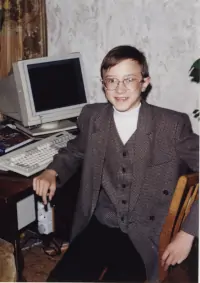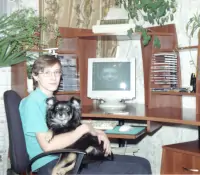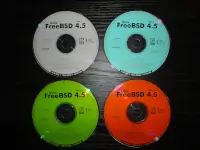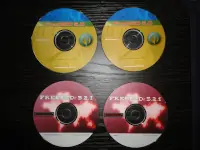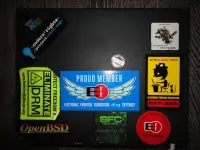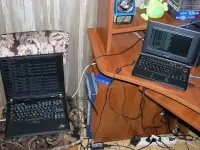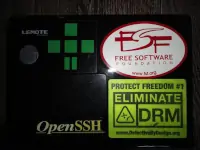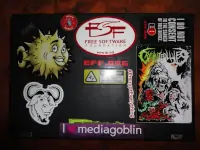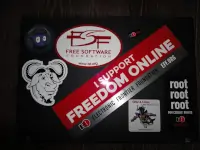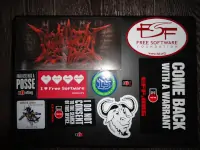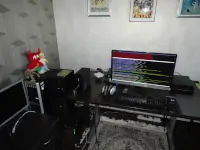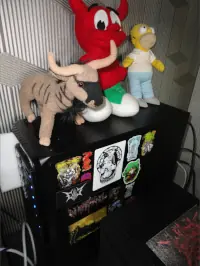Next: Dotfiles, Previous: My hardware and software details, Up: Sergey Matveev’s homepage
My hardware and software history ¶
I do not remember very clear all my computer hardware and software history. So here are very crude memories.
| Approximate time | Description | Ware details |
|---|---|---|
| ~1989-1990 | My first computer was ZX Spectrum assembled by my father using brutal soviet space-related connectors, wires and cases. I was something like 4-5 years old. I used to play more than a hundred games on it. It included BASIC programming language manual, that I was reading and wanted to create programs since that time by myself. | |
| 1996 | 286-based IBM PC/AT appeared in our family. One relative just gave it away for free. Mostly I played various games on it, with a dozens of floppies. Volkov Commander was used as a file manager. It was very lightweight, comparing to huge and bloated Norton Commander. | |
| 1997 | 386-based PC. Again we had got it for free. Initially there was no HDD in it. After it appeared, noone understood how can that capacity be filled with anything. | |
| 1998 | That computer was powerful monster that we upgraded several times. I
became something like an advanced user, helping anyone with anything
related to PCs, building and assembling all that stuff.
I began to use various software, study it, trying to program, play with various operating systems, and so on. I loved that computer! That DX4 120 MHz CPU was powerful enough to run software/games aimed for Pentium-90. It could even play MPEG-1 and MP3 multimedia formats. |
|
| End of 1990s | Many of my school comrades purchased powerful new shiny
Pentium-based PCs and their obsolete 286/386 machines had no value
anymore. Our family (space engineers in 1990s Russia) was rather
poor and can not afford upgrading for completely new computer. All
previous hardware was taken for very low prices, mainly second-hand
one. So our 486 was already rusty enough comparing to modern
computer people had.
I took those 286/386 machines people wanted to junk out. I connected them with LPT and COM-ports to be able to play games like Doom together. That was wonderful time! | |
| ~2003 | I had got internal 9600bps modem for free. I did not know what
to do with it, but some shareware software had an advertisement of
(russian, Moscow-located)
BBS.
I called it, connected for the first time, completely changed my life.
I spent hours on BBSes downloading various stuff, including list of another BBSes. I persuaded my parents to buy higher speed external modem. That was EliteGroup one. Later I exchanged it for Courier V.everything. The best modem at that time I could imagine. I loved hours spent with it with configuration increasing my rates on BBSes. One of the files I have downloaded was
"64 kilobytes about the FidoNet".
I wanted to join FidoNet.
Internet was pretty expensive and useless, but I bought several
times РОЛ dialup ISP access cards for occasional connections.
I registered |
|
| Middle 2000s | Computer on which I have started active programming and using of
Unix-like operating systems. I met
How to become a
hacker (by Eric S. Raymond) book (translated to russian), read it,
decided and understood that Unix is the only right way. My first
Unix-like OS was Mandrake, that I got on my birthday. I have spent
so many time with it! Later was RedHat. I was studying programming
on Perl.
Also I can never forget the day then I saw FreeBSD 4.5 distribution on 4 CDs on radio market and asked my parents to buy it. At first, that was very complicated task to install that OS, because no Internet connection, noone I could ask to help me. But soon I loved that OS and then worked with FreeBSD up to 5.X series. I worked on FreeBSD more than six years. All FidoNet software was working on it perfectly. Of course I still played many games on it. But even Quake 3 was running perfectly under FreeBSD with Linux-emulation layer enabled. Still remember how I downloaded ~30 MB executable of Quake3 for GNU/Linux systems for the whole night long over our noisy telephone lines. |
|
| ~2004 | Motorola cellular phone appeared and used exclusively as a GPRS modem for Internet access. Since then I began to use Internet, because at least I was paying only for the traffic, not spent time. I have never entered Internet on Windows system – I have already moved to FreeBSD/GNU/Linux. However most of traffic was passing through the FidoNet. | Motorola C350L cellular phone. |
| ~2004-2005 | K6-2 computer is parent’s one, Athlon appeared as my own. Many
upgrades were done on it that I do not remember. That was my main
working computer for many years, where I began to work
professionally.
ADSL Internet access appeared with 160/128 (downstream, upstream) Kbps speeds, later increased to 2+ Mbps/512Kbps. I used BitTorrent and created online services with IPv4 static address. I also run Tor exit node. |
|
| ~2005-2006 | One man gave me for free his Nokia cellphone. After ADSL appeared in our home, no GRPS modem connectivity required. I gave Motorola to my friend. Well, Nokia was rather good quality cellphone. | Nokia 5100 |
| 2006 | Started extensive usage of POSIX shell, Ruby and Ruby On Rails, being the part of Inquisitor project. | |
| 2006 | One of my first salary was spent for Palm PDA. It served me till middle of 2010s. That was the best handheld device I have ever used! I wear it everywhere, making huge quantity of notes with its wonderful graffiti typing system – I typed faster than anyone could with their on-screen keyboards. | Palm Tungsten E2 |
| ~2008 | I purchased ThinkPad laptop and used as a main workstation,
leaving Athlon to host Internet services all days long. It was
the best laptop I had – no touchpad, three button mouse, very
high quality keyboard, heavy, strong, powerful, reliable. I used it
at work, at institute, at home, everywhere. That was the first
Intel-based (except for 286) computer in our family.
I tried to use Ubuntu, Debian GNU/Linux distributions, because my work involved many hardware and Linux-specific tasks. I used GNU/Linux for seven years since then. Ubuntu sucks – very low quality. Debian was my most favourite distribution. I used it since 4.0 till 7.0. After its display breakage I used it as a gateway at home, hosting all Internet related things, email server, Tor exit node, torrents. | ThinkPad R60e
|
| 2006-2007 | I was interested in free software movement much and became FSF member (supporter) and FSFE fellow. I completely abandoned proprietary software world. | |
| ~2009 | Because of GNU/Linux inside, I bought Motorola Ming smartphone. Well, I liked it. Very beautiful in my opinion with hackish speaker placement. I paired it with Palm handheld for reading/writing SMSes and synchronizing contacts (as far as I remember). It is still the only mobile device with built-in camera I have ever had. It was drained two times, rusted and broke after a while. | Motorola A1200e |
| 2008-2010 | I bought and used for several years Lemote YeeLoong netbook, making
all my institute-related works, drawings, presentations, documents
and my professional programming.
It had buggy CPU and one of Debian updates did not include the bugfix, so it became broken (stalls after random time) and I did not know about that bug and decided that it ended his life completely (however I just could downgrade the Debian). | Lemote Yeeloong
|
| ~2010 | I used EeePC 701 netbook after that. With an external monitor and keyboard it was pretty acceptable (and very cheap) computer to work on. I used it as my main workstation for quite long time. | EeePC 701
|
| 2010+ | Athlon and ThinkPad gateway/servers were replaced with GuruPlug. It worked for some time, but had huge problems with heating. After some update it stopped booting. I did not have JTAG connector for reaching console, so I quickly (because it acted like email server, Tor node) replaced it with EeeBox nettop – cheap and good enough, quiet, low-power computer. | GuruPlug Plus
|
| ~2010-2011 | For supporting fully free software based cellphones, I bought OpenMoko one. Honestly its audio quality sucked. You had to solder something (I asked for help one guy on work) in it, to make its microphone less buzzing. But it voice, SMS, Internet and WiFi worked. I gave it to one of my colleagues in 2015-2016 – it was still working. | Neo Freerunner |
| 2011 | I lead OpenSAN
(OpenSAN.org) project development. It was free software
SAN based
on OpenWRT.
Also I started to learn Python with Django. | |
| ~2012-2013 | I wanted to purchase a good and powerful laptop again. ThinkPad T420 was it. Nothing especial. Relatively good. I used it with Debian, but after systemd shit appeared, that distribution began to smear. I abandoned GNU/Linux world and switched back to FreeBSD, already containing huge quantity of improvements for that 7 years I missed it. | ThinkPad T420
|
| ~2012-2013 | I replaced my Freerunner with OpenPhoenux – more modern 3G cellphone with free software inside. It was several times more expensive than Freerunner, but it had satisfactory microphone out-of-box, without any hacks. It was really high quality, made in Bavaria with fast 3G connectivity. It served me 6-7 years. | OpenPhoenux/GTA04 |
| 2013 | I fully moved to programming on Python. Also with much SQL. |
|
| ~2013-2014 | I purchased full-featured real server, that looks like
FreeNAS Mini.
Later I bought second one. One of them is still used as a gateway
and Internet-connected server, another one is not so critical and
sometimes used for heavy long-term computation tasks.
They are perfect! Very quiet (my Dell laptop is louder!), very reliable, high performance, no compatibility problems, high-end quality chipset, SATA and network controllers. |
|
| ~2014 | For very low price I bought ThinkPad X201i laptop with partly broken display. It is some kind of backup for my main working computer. And it really saved me once when police seized nearly all my hardware for weeks because of Tor exit-node! | ThinkPad X201i
|
| 2015 | I tried, loved and fully moved to programming on Go language at ivi.ru. Then I have changed my workplace and unfortunately returned back to programming on Python. | Go |
| 2016 | I purchased Filco tactile keyboard and that completely changed my life. Since then I absolutely unable to work with anything, but tactile keyboards. And I stopped worrying about laptop keyboards at all – anyway I won’t use them except for seldom occasions. But because laptop is placed too far, because of keyboard in the front, I also have to use an external monitor. So I have also stopped worrying about laptop’s display at all. Actually laptop for me is just a portable case, nothing more, where in few occasions I can use its terminal capabilities. | Filco Majestouch 2 tactile keyboard with MX Blue switches. |
| 2017 | 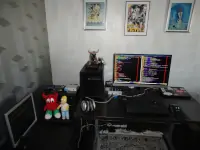
I gave my ThinkPad T420 to parents and bought Dell Latitude 3470. ThinkPads became much more expensive and Lenovo’s ones have not so high quality, so I decided to buy relatively cheap laptop. | Dell Latitude 3470
|
| 2018-2019 | I have bought Ultrium tape drives – the very long wanted storage. First tape drive was second-hand and served me nearly a year. Second one is an external one, the same model. | SAS Ultrium LTO-5. 70+ LTO 4/5 tapes (800 GB/1.5 TB capacity) |
| 2019 | I replaced my GTA04 cellphone with Philips Xenium. It works for nearly 1.5 week with two SIM cards installed on single battery charge. | Philips Xenium E109 |
| 2020-07-01 | One of my Filco Majestouch keyboards broke. Replaced it with Das Keyboard one. 2-port USB3 hub, millimeter ruler at the back, multimedia keys with volume regulator scroller, aluminium top panel and completely blank keycaps. | Das Keyboard 4 Ultimate |
| 2021-08-20 | Dell laptop started to lag and only single USB port left working. So it was replaced. I do not use laptops anymore. | Intel NUC9i9QNX
|
| 2023-08-21 | One of my servers became almost dead, with broken power supply, fans and occasional reboots. Replaced it with modern midtower solution. |
|
| 2023-09-12 | All home computers got 10GbE connectivity. |
|
| 2024-05-04 | HiDPI experience started. | Samsung S27A800 LCD monitor |
| 2024-05-24 | Replaced Philips cellular phone with Nokia one with VoLTE support. | Nokia 110 4G DS |
| 2025-01-29 | GNSS receiver for more precise NTP clocking. | USB u-blox GPS/GLONASS/Galileo/QZSS |

